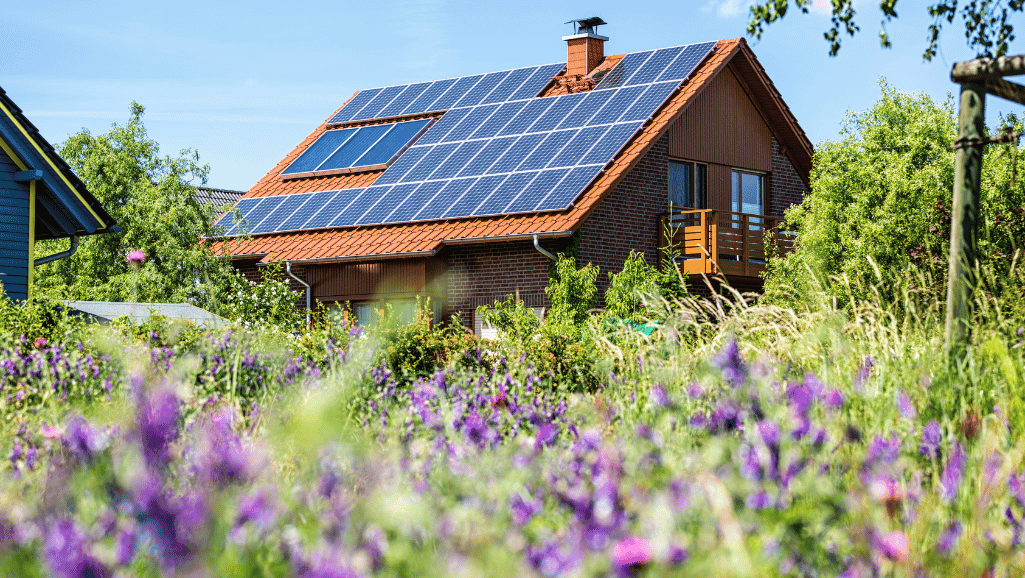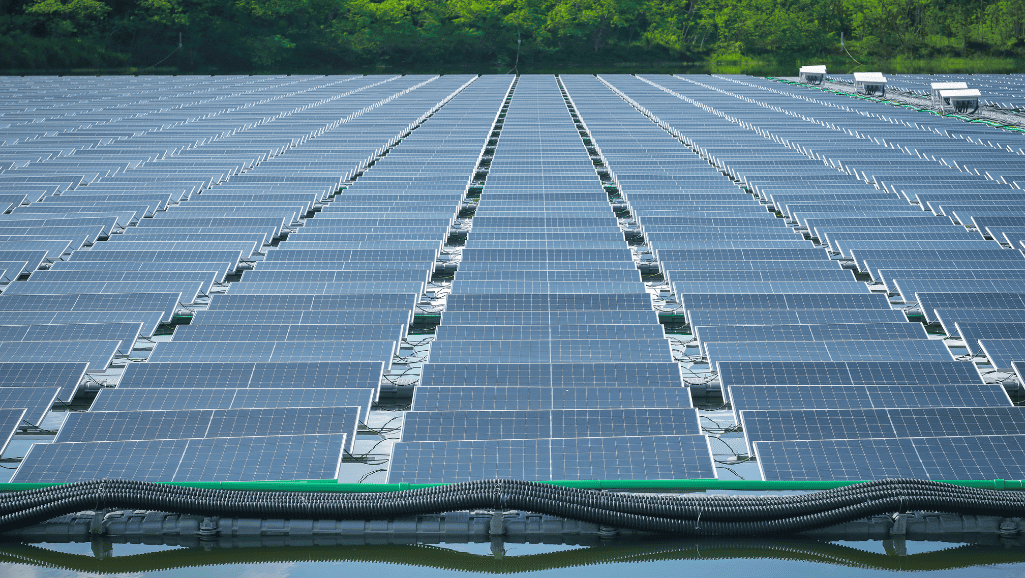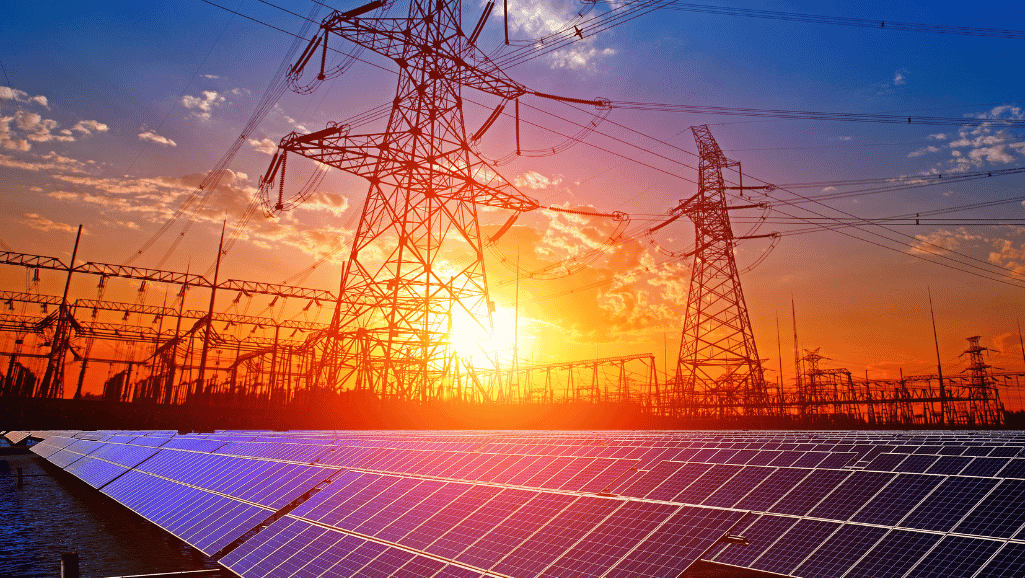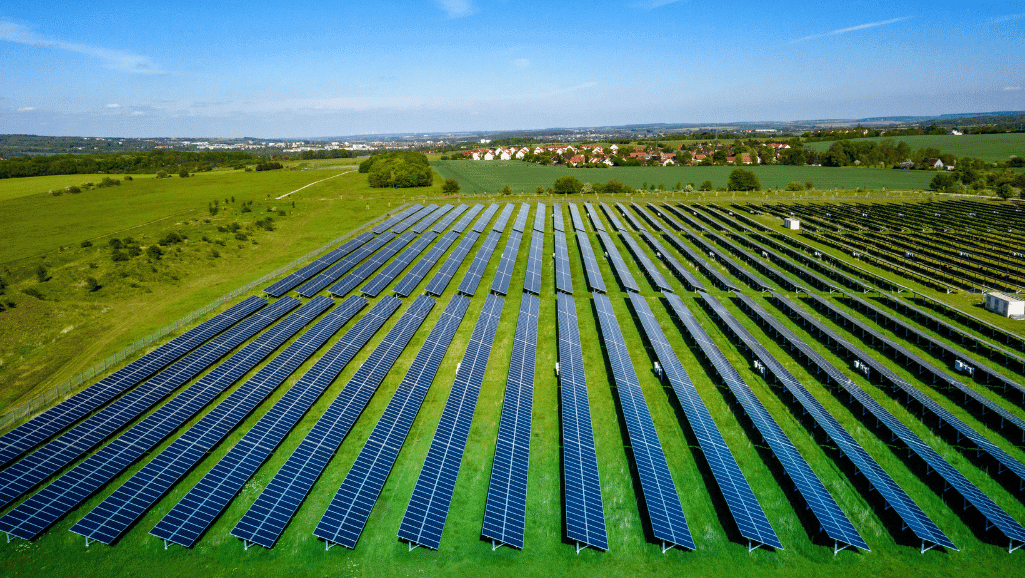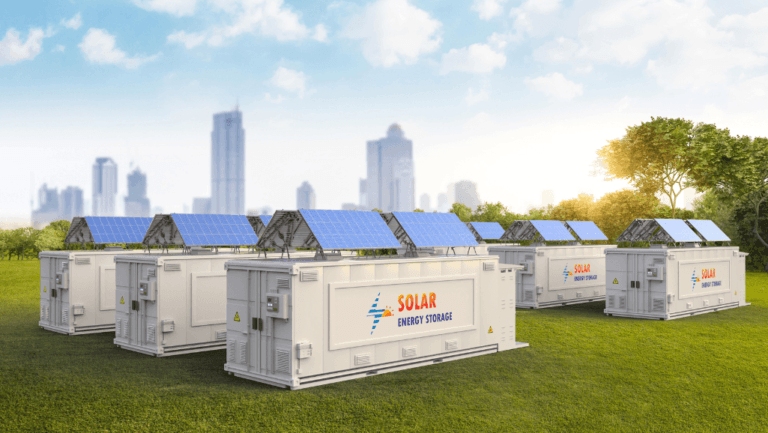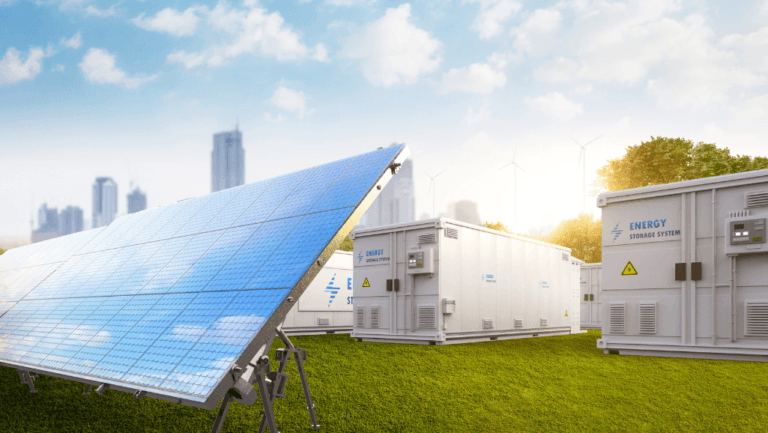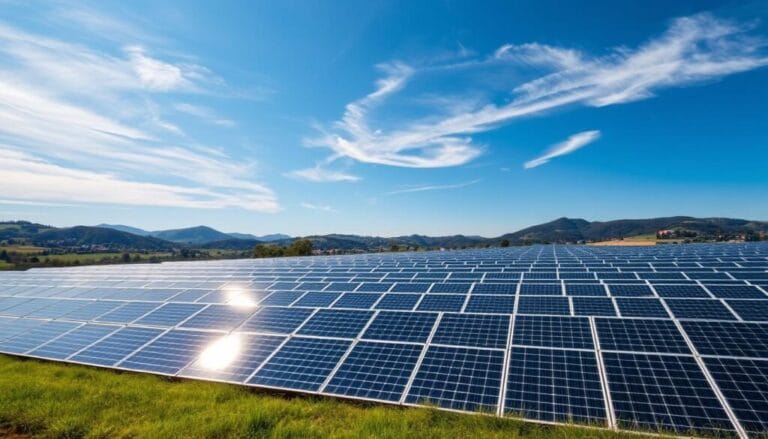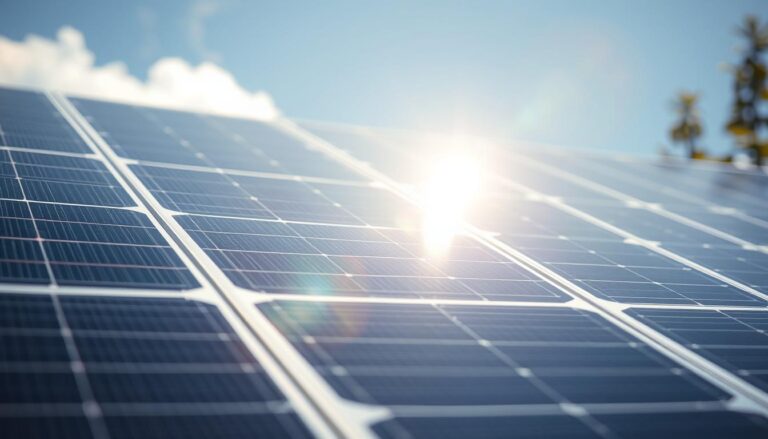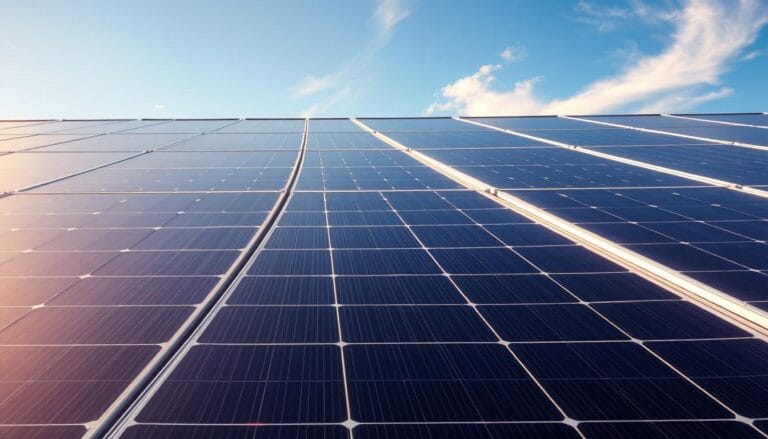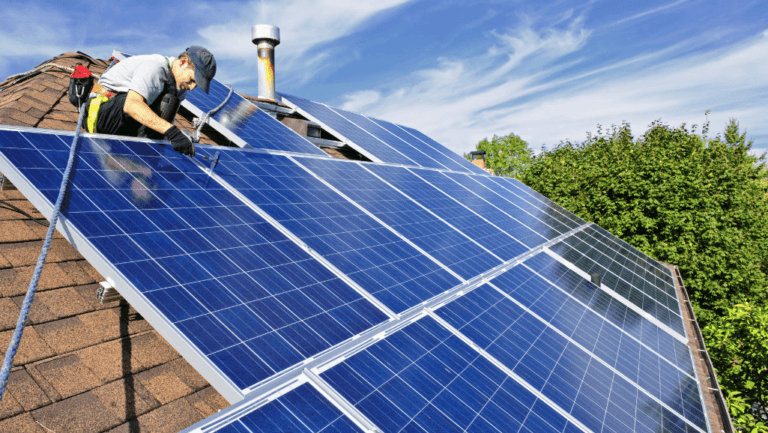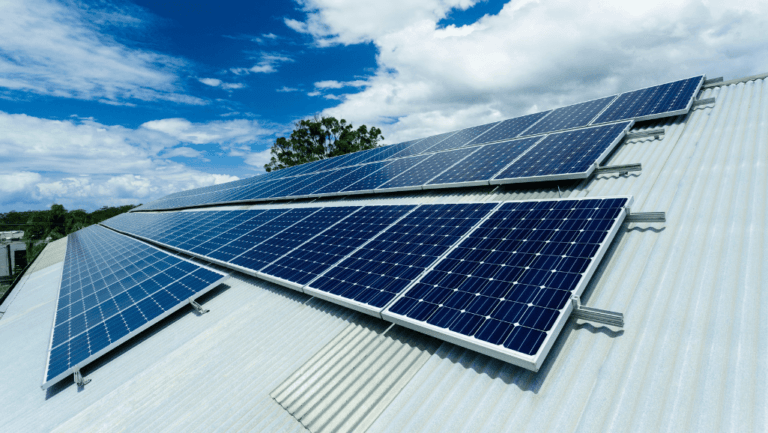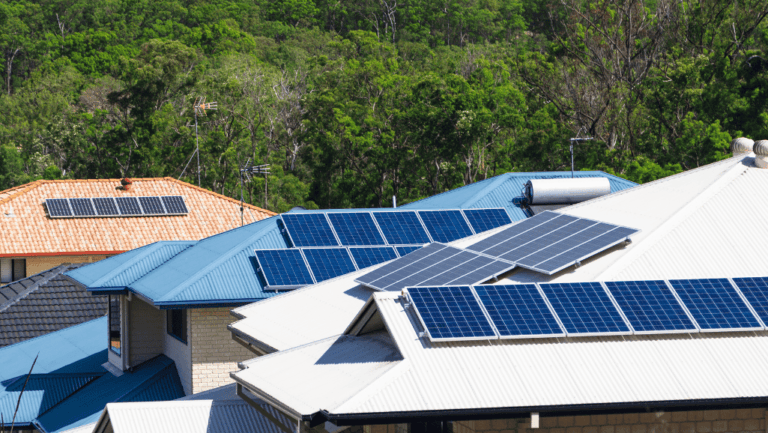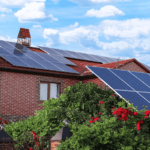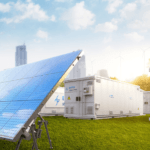Solar panels are changing how we use renewable energy. They turn sunlight into electricity in a cool way using photovoltaic cells. Now, more people and companies are choosing solar panels to cut down on energy costs and carbon emissions.
Solar power starts with silicon cells laid out like a grid. When sunlight hits these cells, it starts a reaction that makes electricity. This simple idea is leading us into a future of clean energy. How Do Solar Panels Work
Today’s solar energy systems are better and cheaper than before. Thanks to new photovoltaic technology, solar panels work well even on cloudy days. This makes solar power a great choice for those wanting to use renewable energy.
Key Takeaways
- Solar panels use photovoltaic cells to convert sunlight into electricity
- Silicon is the primary material used in solar cell construction
- Solar energy systems can power homes and businesses efficiently
- Modern panels work well even in less-than-ideal weather conditions
- The cost of solar installations has decreased significantly in recent years
- Solar panels can increase property values by an average of 3.74%
Introduction to Solar Energy
Solar energy is a key player in renewable energy, offering a strong way to make sustainable power. It uses the sun’s energy to make electricity, thanks to green technology.
What is solar power?
Solar power turns sunlight into electricity with photovoltaic (PV) panels or concentrated solar systems. This green energy source is popular for being sustainable and efficient. Amazingly, the sun’s energy for just 1.5 hours could power the whole world for a year.
The rise of solar technology
Solar tech has grown fast, thanks to lower costs and better performance. It started in 1839 and got a big boost with the silicon PV cells in 1954. Now, China is the top producer, followed by the US, Japan, Germany, and India.
Benefits of solar energy
Solar energy has many benefits for making power:
- Lower electric bills
- Less carbon emissions
- Job creation and economic growth
- Improved grid reliability
- Works well for small and big projects
| Aspect | Solar Energy Impact |
|---|---|
| Environmental | Renewable and infinite source with shrinking carbon footprint |
| Economic | Lower electricity costs and job creation |
| Technological | Efficient at small and large scales, integrates with existing grids |
| Versatility | Used in homes, businesses, and large projects |
Solar power keeps getting better, promising a future with more energy and less pollution.
The Basics of Photovoltaic Cells
Photovoltaic cells are key to turning sunlight into electricity. They work by using the photovoltaic effect. This process is made possible by silicon semiconductors, which are the main part of most solar panels.
Silicon solar cells are the top choice, making up 95% of solar panels sold. They are loved for their strength and how well they work. Even after 25 years, they still produce over 80% of their original power.
When sunlight hits silicon, it makes electrons move. This movement creates an electric field. As these electrons flow, they make electricity that we can use.
| Solar Cell Type | Efficiency | Key Feature |
|---|---|---|
| Crystalline Silicon | 15-25% | Most common, long-lasting |
| Perovskite | Up to 25% | Rapidly improving efficiency |
| Organic PV | 7-12% | Potentially lower cost |
| Multijunction | Over 45% | Used in space exploration |
Over the years, solar cells have gotten much better. They used to be under 10% efficient in the 1980s but now they can reach nearly 25%. This has made solar energy a strong choice instead of fossil fuels.
This progress is huge. Now, big solar farms make a lot more electricity than before. In 2004, they made 6 million kilowatt-hours, but by 2023, it was 162 billion kilowatt-hours. This shows how important photovoltaic cells are for our clean energy future.
How Do Solar Panels Work?
Solar panels use sunlight to make electricity in a cool way. This solar technology has changed how we make energy, making it cleaner and greener.
Step 1: Sunlight Activation
Sunlight starts the process when it hits the solar panel. These panels have photovoltaic cells, usually made of silicon, for catching sunlight. When sunlight hits these cells, it makes the electrons inside the silicon move.
Step 2: Electron Movement
The moving electrons create an electric field in the cell. The cell’s design, with its silicon layers and metal plates, helps guide these electrons. This makes sure they move in the right direction.
Step 3: Electrical Current Generation
The moving electrons make an electrical current. This is the raw energy from the solar cells. The metal plates catch this current and send it through the wiring of the solar power system.
Step 4: Conversion to Usable Electricity
The last step uses an inverter to change the DC electricity to AC. AC is the type of electricity we use at home. The inverter makes sure the solar power works with our electrical systems and devices.
| Step | Process | Key Component |
|---|---|---|
| 1 | Sunlight Activation | Photovoltaic Cells |
| 2 | Electron Movement | Silicon Layers |
| 3 | Current Generation | Metal Plates |
| 4 | Electricity Conversion | Inverter |
Solar panels keep making electricity all day. They power homes and send extra energy back to the grid. Solar panels are about 15% to 20% efficient, but top models can hit up to 23% efficiency under perfect conditions.
Types of Solar Panels
Solar panels come in different designs, efficiencies, and prices. Knowing these differences helps homeowners pick the best one for their needs. Let’s look at the main types of solar panels and what makes them special.
Monocrystalline Solar Panels
Monocrystalline panels are at the top in silicon photovoltaics. They have high efficiency, usually between 17-22%. These panels can make over 300-400 watts of power, perfect for small roofs. They also look sleek and black.
Polycrystalline Solar Panels
Polycrystalline panels offer a good mix of cost and performance. They work between 15-17% efficiently and make a bit less power than monocrystalline ones. They stand out with their blue color and silver frames. These panels are cheaper because they’re easier to make.
Thin-Film Solar Panels
Thin-film solar technology is the latest in solar panels. These panels are light and flexible, with about 11% efficiency. They’re not as efficient as crystalline panels but are affordable and work well in heat. They’re often used in big commercial projects.
| Panel Type | Efficiency | Power Output | Cost | Appearance |
|---|---|---|---|---|
| Monocrystalline | 17-22% | 300-400W+ | Highest | Black |
| Polycrystalline | 15-17% | Lower than mono | Moderate | Blue |
| Thin-film | ~11% | Varies | Lowest | Black or Blue |
When picking solar panels, think about space, budget, and energy needs. Monocrystalline panels are the most efficient but cost more. Polycrystalline panels are a good middle choice, and thin-film technology is best for certain uses. For most homes, monocrystalline panels are recommended for their high efficiency and savings.
Components of a Solar Power System
A solar power system has several key parts that work together to use the sun’s energy. Solar panels are at the core, catching sunlight and turning it into electricity. Most panels are monocrystalline, which are the best and last the longest, making up 75% of the market.
Solar racking is important for holding panels in place. Most homes use roof mounts, but bigger setups might use ground or pole mounts. The choice depends on how much space and sunlight you have.
A solar inverter changes the DC electricity from panels into AC electricity for your home. There are string inverters and microinverters. Microinverters are better for adding more panels later because they last longer and are more flexible.
For storing energy or off-grid use, solar batteries and charge controllers are key. Lithium-ion batteries are often chosen for their high energy storage and long life. A charge controller makes sure the batteries charge right, keeping them working well and lasting longer.
How well a solar power system works depends on the panels, inverters, and how well it’s installed. Good solar panels can last 25 years, making them a smart choice for clean energy.
Efficiency and Performance Factors
Solar panel efficiency is key in renewable energy. It shows how much solar radiation a panel turns into electricity. Today, commercial panels have efficiency between 15% and 22%. This shows big improvements in solar tech.
Solar Panel Efficiency Ratings
Many factors affect how well photovoltaic cells work. Wavelength, temperature, and reflection all matter. For example, panels work best between 15°C and 35°C. High temperatures can cut efficiency by 10% to 25%.
Factors Affecting Solar Panel Performance
Many things affect solar panel performance. Orientation, tilt, and local weather are important. Shading is a big problem, causing big power losses. To fight this, bypass diodes are used. They let panels work even when some parts are shaded.
Maximizing Solar Energy Output
To get the most from solar panels, install and maintain them right. Place panels at the best angles and keep them clean. Regular checks keep them working well. New tech like microinverters can improve energy output. They let each panel work on its own, making the system more efficient.
| Factor | Impact on Efficiency |
|---|---|
| Temperature | 10-25% reduction in high heat |
| Shading | Significant power loss |
| Orientation | Crucial for maximizing output |
| Maintenance | Regular cleaning boosts performance |
Solar Panel Installation and Maintenance
Installing solar panels is a big step towards using clean energy. For homes, experts look at your house’s design to plan the best setup. Commercial setups need more planning because they handle more energy and are bigger.
After putting them up, solar panels are easy to take care of. Solar panel maintenance usually means cleaning them a few times a year. Rain can wash them clean, so you don’t need to clean them as much. But, for the best performance, use a soft brush and gentle cleaner after a lot of snow.
Checking on them regularly helps spot problems early. Solar panels work less well as it gets hotter than 77°F. Things like leaves, bird nests, and bad weather can make them work less efficiently. Even though they can handle a lot, it’s best to get help from experts if they need fixing.
Here’s how solar panels stand up to different weather:
| Weather Condition | Solar Panel Performance |
|---|---|
| Wind and Rain | Generally withstand well |
| Snow | Can handle, but may need cleaning |
| Hurricanes | Limited damage (Hurricane Florence 2018) |
| Hail and Tornadoes | Possible damage, rare occurrences |
For full solar solutions, think about Solar Powers World. They give expert advice on setting up, keeping them running, and getting the most from your solar setup for homes and businesses.
Conclusion
Solar panels have changed how we get energy, leading to sustainable living and a future powered by renewable energy. These devices use silicon-based semiconductors to turn sunlight into electricity. Since their discovery in 1839, solar power technology has grown a lot, offering a clean alternative to fossil fuels.
Solar power does more than just cut down on electricity bills. It’s a key part of green energy solutions, making no harmful emissions or pollutants. The Earth gets about 173,000 terawatts of solar energy every minute, showing the huge potential of this renewable source.
Looking ahead, solar panels are crucial for a renewable energy future. Improvements in solar technology, storage, and smart energy management are making solar power better and easier to use. By choosing solar energy, we’re not just saving money on bills. We’re building a cleaner, sustainable world for the future.


